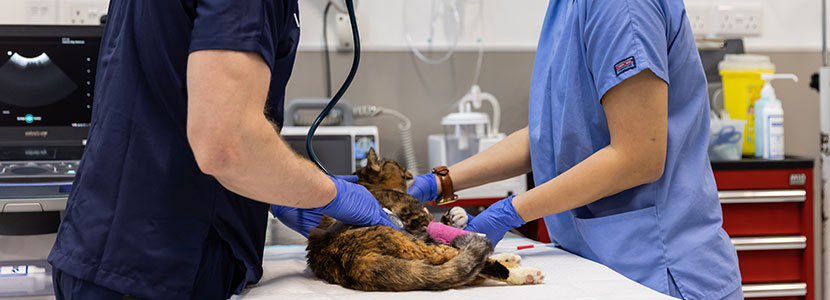
Pet emergencies can happen unexpectedly, and acting fast can make all the difference. That’s why it’s important to stay alert and informed – these 10 warning signs could mean your pet needs immediate medical attention.
10 Warning Signs Your Pet Needs Emergency Care
1. Persistent Vomiting
If your pet vomits, you’re likely worried about what’s causing it. Vomiting in pets can range from mildly concerning to potentially life-threatening conditions, though not every instance requires immediate attention.
Seek immediate veterinary care if your pet has:
- Multiple vomiting episodes within a 24-hour period
- Vomiting combined with other symptoms like diarrhoea or lethargy
- Vomiting after potentially consuming something toxic or swallowing a foreign object
Severe vomiting has many possible causes, from eating something they should not have to complex diseases. If your pet shows any of these warning signs, it’s best to visit your vet right away.
2. Severe Diarrhoea
Diarrhoea, which appears as loose or watery stools, is a common reason pet owners seek emergency veterinary care.
You should consider your pet’s diarrhoea an emergency when it is:
- Bloody in appearance
- Unable to be controlled
- Occurring multiple times in a 24-hour period
- Happening alongside other symptoms like vomiting or signs of pain
- Following possible ingestion of something toxic
Like vomiting, diarrhoea can be linked to many possible reasons – some quite serious and requiring prompt attention – especially because severe diarrhoea can quickly cause dehydration in your pet.
3. Uncontrolled Bleeding
Pets sometimes bleed from cuts, lacerations, or injuries. Minor cases can be managed at home with basic first aid, such as applying pressure or covering it with clean gauze.
You should seek immediate veterinary attention if your pet’s bleeding is:
- Unable to be controlled
- Resulting from trauma
- From deep wounds like bite marks or punctures
- Causing significant blood loss
When you visit an emergency vet, they’ll thoroughly assess the source of bleeding, make sure there are no complications, and provide proper treatment – which may include stitches or dressings.
4. Difficulty Breathing
Many signs of respiratory distress in pets are veterinary emergencies.
Watch for these signs that require immediate care:
- Wheezing or laboured breathing
- Unusually fast, raspy, or shallow breathing
- Struggling to get enough air
- Changes in how quickly your pet breathes
- Breathing with mouth open (only for cats)
These breathing difficulties can result from various conditions, including heart or respiratory problems, asthma, allergic reactions, trauma, etc. – all of which require prompt medical attention.
5. Inability to Urinate
What appears to be simple urinary issues could be serious medical emergencies requiring immediate attention — especially in cats.
Warning signs that indicate an emergency include:
- Inability to pass urine
- Straining during urination attempts
- Presence of blood in the urine
- Crying/howling while trying to urinate (indicating that your pet may be in pain)
These symptoms may point to a urinary blockage or obstruction, which can quickly become life-threatening, potentially leading to bladder rupture and cardiac arrest. These issues may stem from urinary tract infections (UTIs) or underlying problems like stones, crystals, or bladder cancer.
Male cats face a particularly high risk of these emergencies due to their anatomy, making them especially prone to developing urinary blockages and obstructions.
6. Unexpected / Severe Seizures
Seizures can be alarming, especially if your pet has never experienced one before. They can appear differently depending on your pet and the type of seizure.
Look out for these warning signs that indicate a seizure:
- Temporary loss of consciousness
- Muscle stiffness followed by paddling of paws (looks like they’re swimming)
- Sudden collapse
- Excessive drooling or foaming at the mouth
- Disoriented behavior or altered perceptions of surroundings
- Uncontrollable shaking or trembling
What to do if your pet has a seizure:
- For first-time seizures, contact your family vet immediately or go to an emergency clinic if they’re unavailable.
- If your pet has a history of seizures, follow your vet’s established guidelines.
- For multiple seizures or episodes lasting more than a few minutes, head to an emergency vet right away.
Seizures may result from various underlying conditions, including epilepsy, liver disease, ingesting poison, or head trauma.
7. Inability to Walk
If your pet has trouble walking normally, get veterinary help right away. Mobility issues can seriously impact your pet’s well-being and may signal a severe underlying health issue.
Watch for these warning signs:
- Collapsing when trying to stand
- Dragging back legs
- Unsteady, stumbling, or lack coordination
- Limb paralysis
- Limping that shows signs of injury
- Stiff or rigid limbs
These symptoms could result from injury, spine problems, or other long-term illnesses.
8. Swollen Abdomen
The sudden appearance of a significantly distended or swollen abdomen requires immediate veterinary attention. This alarming sign often points to gastric dilatation and volvulus (GDV), commonly known as “bloat” – a life-threatening condition where your pet’s stomach expands with gas and food before twisting on itself.
Watch for these warning signs alongside abdominal swelling:
- Retching that produces white foam
- Elevated heart rate and breathing
- General discomfort and reluctance to lie down
Certain breeds face higher risk, particularly:
- German Shepherds
- Standard Poodles
- Great Danes
- Weimaraners
- Irish Setters
- Irish Wolfhounds
- Saint Bernards
While other conditions can cause abdominal distension, GDV is one of the most common emergency room diagnoses. These cases demand swift action, typically requiring emergency surgery to save your pet’s life.
9. Loss of Consciousness
Loss of consciousness in pets requires emergency veterinary care, as it may reveal hidden, life-threatening conditions that need immediate medical intervention.
Signs that your pet is experiencing a fainting episode include:
- Sudden collapse to the side
- Unresponsive or limp body
- Abnormally pale gums
- Possible loss of bladder or bowel control
These symptoms can resemble seizures, so describing exactly what you observed to your vet is crucial for accurate diagnosis.
Fainting typically occurs when the brain doesn’t receive adequate blood flow, which may indicate underlying heart conditions or brain-related issues.
10. Major Injuries
While minor injuries may not require immediate attention, your pet needs prompt veterinary attention for serious injuries, including:
- Broken bones or fractures
- Deep cuts or lacerations
- Eye injuries
- Bite wounds
- Head injuries
- Dislocated joints
- Strains or sprains
Remember that seemingly minor external wounds might hide more serious internal damage. Traumatic events like car accidents, falls, or fights with other animals often cause injuries more severe than they first appear.
Don’t wait to seek help if you notice anything unusual in your pet’s behavior after an injury. Prompt veterinary care can prevent complications and ensure proper healing. When in doubt, it’s always better to have your pet examined by a professional.
Next Steps: What You Should Do During a Pet Emergency
What to Do:
- Call the emergency vet and inform them of your pet’s condition.
- Prepare for your visit by bringing necessary medical records or medications.
- Transport your pet safely, keeping them calm and avoiding further injury.
What Not to Do:
- Do not medicate at home unless specifically instructed by a vet.
- Do not attempt to fix an injury, such as setting a broken bone yourself.
- Do not rely solely on online information; always consult a veterinary professional.
What You Can Expect at the Emergency Vet Hospital
Understanding what to expect at the emergency vet hospital can help you stay calm and focused during this stressful situation, ensuring your pet receives the most appropriate and effective emergency care for their specific condition.
1. Triage
Upon arrival, your pet will undergo a triage assessment where the emergency team will evaluate vital signs, including temperature, heart rate, and respiratory rate.
This helps determine the severity of their condition, with critically ill or injured pets receiving priority for immediate medical attention.
2. Questions from the Vet
After triage, you’ll meet with a vet who will examine your pet thoroughly. The veterinary team will ask for more details about:
- Current medications
- Symptom duration
- Recent injuries or accidents
- Possible ingestion of harmful substances
- Vaccination history
- Diet and activity level
- Any additional symptoms
Being comprehensive and precise with these details is crucial, as even seemingly minor information can provide valuable clues for diagnosis.
3. Diagnostic Tests
Based on your pet’s symptoms and examination findings, the vet may recommend several diagnostic tests to pinpoint the cause of their condition, including:
- Blood work to assess overall health and detect signs of disease or infection
- Urinalysis to evaluate kidney and bladder function
- X-rays to examine bones, detect fractures, or spot foreign objects
- Ultrasound imaging to look at internal organs in detail
- MRI or CT scans for a comprehensive view of the pet’s body
After completing the necessary tests and ruling out serious conditions, your veterinarian will have valuable information to explain your pet’s condition and discuss treatment options to help them feel better.
4. Treatment
Based on the diagnosis, our vet will determine your pet’s treatment plan. For complex or chronic conditions, your pet might be transferred to a critical care unit for continuous monitoring and treatment. In some cases, the emergency vet may refer you to a veterinary specialist or back to your regular veterinarian for follow-up care and long-term management.
Supporting You and Your Pet Through Every Challenge

In an emergency, every second counts. As a 24-hour vet hospital, VES Hospital is here for you round the clock, providing professional care when your pet needs it most. If you’re ever unsure about your pet’s condition, don’t hesitate to reach out — our team is ready to guide you.
